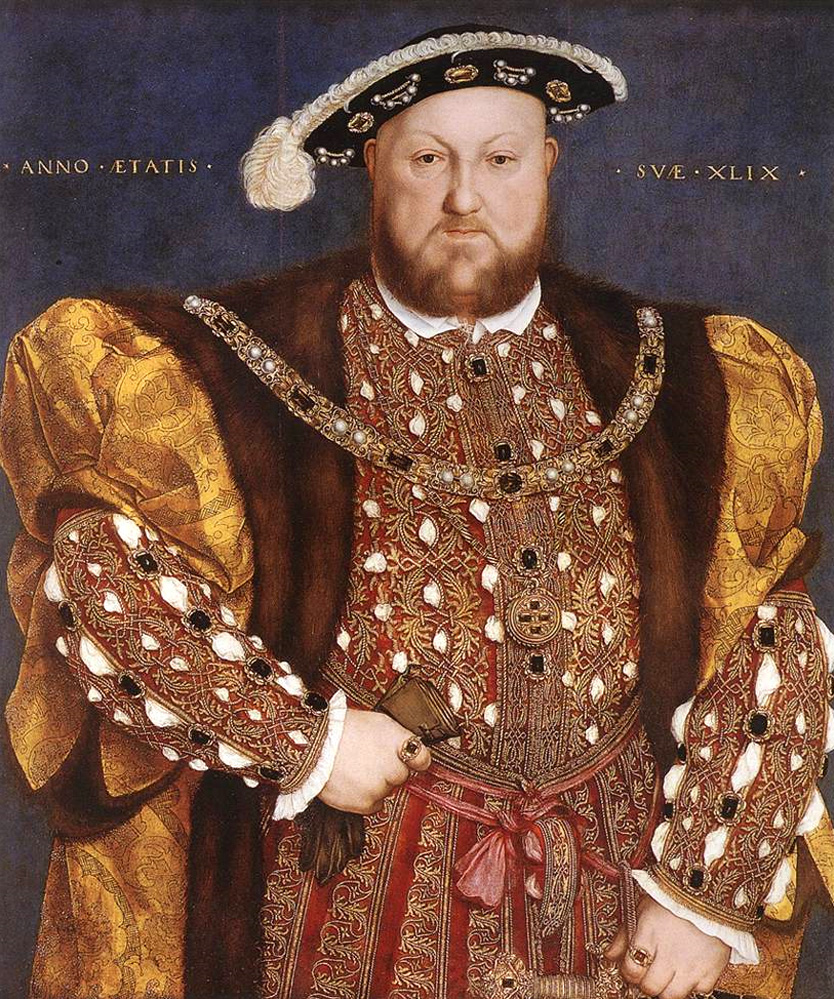

Above: Henry VIII of England (left) married his fifth wife, Katherine, on 28 July 1540 at Oatlands Palace.
28 July 1540 was a momentous day both in the reign of King Henry VIII and in Tudor history more generally; for it was the day in which the king's minister and viceregent in spiritual matters, Thomas Cromwell, was publicly beheaded on Tower Hill for crimes of treason and heresy. That very same day, Henry married for the fifth wife, taking as his consort Katherine Howard, maid of honour to his rejected fourth consort Anne of Cleves. The king was aged forty-nine and his new bride was only sixteen or seventeen.
Historians have puzzled endlessly for the reasons behind Cromwell's abrupt downfall in the summer of 1540. How was it that the most powerful man in the kingdom, after the king himself, who had been raised to the aristocracy in April when Henry granted him the earldom of Essex, fell so suddenly from power and influence? Historians disagree over whether it was Cromwell's radical religious beliefs which brought him into increasing conflict with the conservative king, his role as a scapegoat for the king's ill-fated marriage to Anne of Cleves, or factional manoeuvres at court, that accounts for his spectacular and sudden downfall.

Above: Thomas Cromwell.
It is impossible to know for certain what caused Cromwell's downfall. Possibly, it was circumstances beyond his control. In 1539 he had, with Henry's involvement, engineered a marriage for the king, who was newly single after the death of his third wife Jane Seymour, with Anne of Cleves, a marriage that was particularly significant in that it allied England with the Protestant German princes. This marriage had been arranged to protect England from a hostile Franco-Imperial alliance viewed as potentially harmful to England's security. However, this threat failed to materialise, and Henry did not consummate his marriage with Anne, not necessarily because she was ugly (a lingering myth that exists amidst legends of the six wives), but because he believed she was married to someone else; a cultural worldview that could have prevented him from consummating the union.
Possibly, Henry had fallen in love with Katherine Howard when she arrived at court in the autumn of 1539. He selected her alongside other maidens to serve the new queen, and it was reported to Katherine's step-grandmother, the dowager duchess of Norfolk, that the king had 'taken a fantasy' to Katherine from the moment he saw her. This infatuation with his wife's maiden could have exacerbated difficulties with Queen Anne. Whatever the case, by the early summer of 1540, Henry was determined to annul his marriage to Anne and replace her with the youthful Katherine. Cromwell was cast as a scapegoat for the humiliating failure of this fourth marriage.
Above: Anne of Cleves, briefly queen of England.
On 10 June 1540, Cromwell was arrested at a council meeting and imprisoned in the Tower of London. A bill of attainder was introduced against him into the House of Lords a week later, in which Cromwell was accused of supporting Anabaptists (a radical sect of Protestantism), failing to enforce the Act of Six Articles, and even allegedly plotting to marry the Lady Mary, eldest daughter of Henry VIII. Cromwell begged the king for mercy in a number of desperate letters, but to no avail. He was condemned to death without trial and on 28 July, was beheaded on Tower Hill.
The eminent Tudor chronicler Edward Hall wrote of Cromwell's end thus:
Many lamented but more rejoiced, and specially such as either had been religious men, or favoured religious persons; for they banqueted and triumphed together that night, many wishing that that day had been seven years before; and some fearing lest he should escape, although he were imprisoned, could not be merry. Others who knew nothing but truth by him both lamented him and heartily prayed for him. But this is true that of certain of the clergy he was detestably hated, & specially of such as had borne swynge, and by his means was put from it; for in dead he was a man that in all his doings seemed not to favour any kind of Popery, nor could not abide the snoffyng pride of some prelates, which undoubtedly, whatsoever else was the cause of his death, did shorten his life and procure the end that he was brought unto.
The king later came to dearly regret the loss of Cromwell, terming him 'the most faithful servant he ever had'. He accused his ministers of bringing about Cromwell's end by false charges. But the king felt no such regrets on the day of Cromwell's death, for he was busy marrying Katherine at Oatlands Palace. Although the anonymous Spanish chronicler, writing perhaps a decade later, stated that there were great rejoicings and celebrations at court, the marriage actually seems to have been a low-key affair, much like Henry's marriages to Anne Boleyn, Jane Seymour and, later, Katherine Parr. Eleven days later, on 8 August, Katherine Howard was showed publicly as queen for the first time. She could not have known it then, but she had taken the first step towards tragedy.

Above: Lynne Frederick as Katherine Howard and Keith Michell as Henry VIII in the 1972 film Henry VIII and His Six Wives.
No comments:
Post a Comment